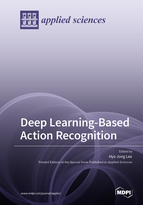Deep Learning-Based Action Recognition
A special issue of Applied Sciences (ISSN 2076-3417). This special issue belongs to the section "Computing and Artificial Intelligence".
Deadline for manuscript submissions: closed (15 November 2021) | Viewed by 44300
Special Issue Editor
Interests: image processing; pattern recognition; artificial intelligence
Special Issues, Collections and Topics in MDPI journals
Special Issue Information
Dear Colleagues,
Human action recognition (HAR) has gained popularity because it can be used for numerous applications, such as health-care services, video surveillance, and human–computer interaction. The key to good human action recognition is robust human action modeling and feature representation. Conventional shallow learning algorithms such as support vector machine and random forest require the manual extraction of some representative features from large sensory data. However, manual feature extraction requires prior knowledge and will inevitably lose implicit features.
Recently, deep learning has achieved great success in many challenging research areas, such as image classification and object detection. The greatest advantage of deep learning is its ability to automatically learn representative features from large-scale data. Now, more and more researchers have also been applying deep learning to human action recognition. However, many challenging research problems in terms of accuracy, device heterogeneity, scene changes, and others remain unsolved.
This Issue intends to prompt state-of-the-art methods on deep learning for human action recognition. We invite researchers to submit research papers in this Issue on Deep Learning-Based Action Recognition.
Dr. Hyo Jong Lee
Guest Editor
Manuscript Submission Information
Manuscripts should be submitted online at www.mdpi.com by registering and logging in to this website. Once you are registered, click here to go to the submission form. Manuscripts can be submitted until the deadline. All submissions that pass pre-check are peer-reviewed. Accepted papers will be published continuously in the journal (as soon as accepted) and will be listed together on the special issue website. Research articles, review articles as well as short communications are invited. For planned papers, a title and short abstract (about 100 words) can be sent to the Editorial Office for announcement on this website.
Submitted manuscripts should not have been published previously, nor be under consideration for publication elsewhere (except conference proceedings papers). All manuscripts are thoroughly refereed through a single-blind peer-review process. A guide for authors and other relevant information for submission of manuscripts is available on the Instructions for Authors page. Applied Sciences is an international peer-reviewed open access semimonthly journal published by MDPI.
Please visit the Instructions for Authors page before submitting a manuscript. The Article Processing Charge (APC) for publication in this open access journal is 2400 CHF (Swiss Francs). Submitted papers should be well formatted and use good English. Authors may use MDPI's English editing service prior to publication or during author revisions.
Keywords
- • image/Video based HAR using deep learning
- • multimodal fusion for HAR using deep learning
- • fusion of shallow models with deep networks for HAR
- • device heterogeneity for device-based HAR
- • scene changes for device-free HAR
- • transfer learning for HAR
- • online learning for HAR
- • semi-supervised learning for HAR
- • survey for deep learning based HAR






